Itinerary edited by SAPIENZA UNIVERSITY OF ROME 

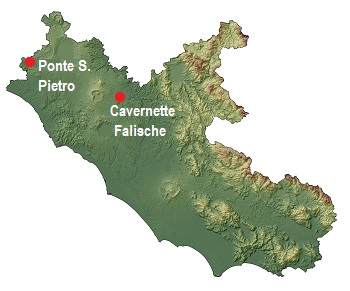
In popular imagination, caves are considered as the typical refuge of prehistoric man. The truth is that man used them toperform rituals or bury the deceased rather than for living, in virtue of their unique conformation and frequent development into intricate small tunnels, the occasional presence of water sources and dripping water which creates spectacular stalactites and stalagmites.
We shall then see how over time, man has "transformed" nature, with the creation of spaces deemed to be suitable for specific activities, such as rituals and funerary rites. Artificial cavelet tombs, dating back to the Copper Age, seamlessly blend into the natural landscape, imitating and researching the characteristics of hypogeous locations, mysterious and hidden away.
This itinerary shall guide you through territories which, despite their vicinity to densely urbanised areas, still preserve evocativefeaturesof ancient landscapes. Examples of such territories include the Tevere valley to the north of Rome and the part of Maremma located between northern Lazio and Tuscany.
 Faliscian cavelets: an example of cultural use of the natural environment
Faliscian cavelets: an example of cultural use of the natural environment
During the Pleistocene, in the northern area of Rome, the Tevere valley was inhabited by hunter-gatherer communities.
Evidence of inhabitation of this territoryduring the middle and upper Palaeolithic age has been found inside small caves and shelters along steep tuffaceous walls running along the entire valley, crossed by minor tributaries of the Tiber.
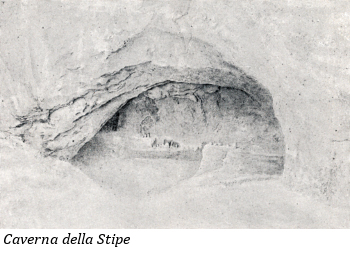
For example, along Rio Fratta, in the Corchiano area (near Viterbo), there are a series of caves known as the Faliscian Caves, which were explored at the beginning of the previous century by Ugo Rellini and later by A. Barra Incardona and A. M. Radmilli. During the Palaeolithic, these locations were merely temporary dwellings, however during later periods, from the Neolithic up to the historic age, the Cavelets were also used for cultural purposes, linked above all to the presence of springs. The term "Faliscian" refers to the name of the ancient territory known as "Ager Faliscus", inhabited by a population of Latin origin who developed a distinctive culture in virtue of their location north of the Tevere, in contact with the Sabines to the right and the Etruscans to the left. The name Faliscian derives from the capital of this ancient territory, Falerii, today Civita Castellana (Viterbo).
The Museum of Origins contains material from excavations conducted by Rellini in the following caves: Caverne di Terra Rossa, della Stipe, dell’Acqua.
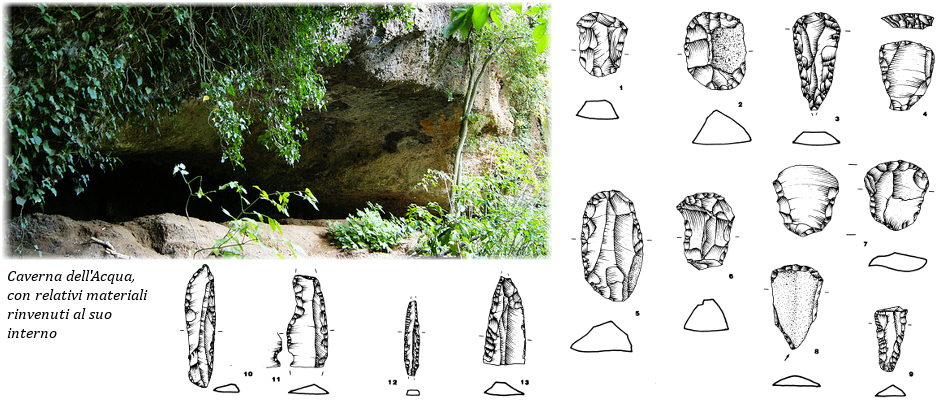
The entrance to the Caverna dell'Acqua is located on the left bank of Rio Fratta, at the confluence of two creeks. Its name derives from the spring located inside. Three layers have been identified which probably contain several highly distinct phases of occupation that are yet to be recognised (Roman Age, Iron Age in the upper layer; Bronze Age and perhaps Neolithic in the middle layer; lithic and ceramic industry in the lower layer). The deepest layer described by Rellini is characterised by lithic and bone industry typically attributable to a later phase of the Upper Palaeolithic (Epigravettian), together with coarse ware, which may indicate a successive phase of Neolithic occupation which was not identified by Rellini during excavations.
Bibliography
Barra Incardona A. 1968 – "Le nuove ricerche nelle cavernette e nei ripari dell’Agro Falisco", Atti della Societą Toscana di Scienze Naturali 76: 101-124.
Mussi M., Zampetti D. 1985 – "Il Paleolitico delle Cavernette Falische: una messa a punto", in Studi di Paletnologia in onore di S.M. Puglisi, a cura di Liverani M., Palmieri A., Peroni R., Roma: 627-646.
Rellini U. 1920 – "Cavernette e ripari nell’agro falisco", Mon.Ant.Lincei XXVI: 6-179.
 From natural caves to small artificial cavelets
From natural caves to small artificial cavelets
From the late Neolithic, the entire Mediterranean area was affected by the phenomenon of hypogeism: underground areas were dug or sometimes existing caves were adapted, for cultural or funerary purposes.
Artificial cavelet tombs were particularly widespread in central-southern Italy during the Copper Age. Between the mid 4th and mid 3rd millenniums BC, eneolithic communities such as the cultures of Rinaldone, Gaudo, Conca d'Oro, buried their deceased in cemeteries which were separate from residential areas. Depending on local tradition, tombs were individual or contained several bodies which probably belonged to the same family group. The deceased were accompanied by rich funerary sets consisting of ceramic vases, perhaps containing offerings, stone, bone and sometimes, copper artefacts. In some cases, there were also ornaments or objects made from particularly valuable raw materials, such as silver. From these elements it can be deduced that an internal structuring of society had begun where the role and level of prestige of individuals was reflected in their funerary set.
The Museum of Origins contains funerary sets from a few tombs discovered in the necropolis of Ponte San Pietro.
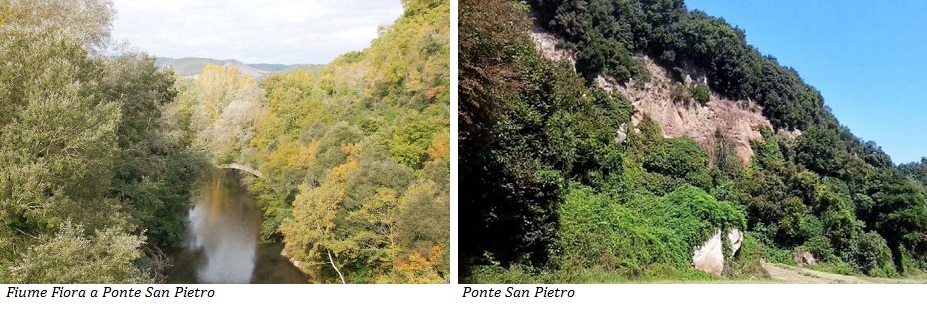

The area with the highest concentration of Rinaldone culture sites is located on the border between Tuscany and Lazio, between the Fiora and Albegna rivers. The necropolis of Ponte San Pietro is one of the most important of these sites and was discovered in 1940 on the occasion of completion works for the Manciano-Farnese road. Excavations were conducted by F. Rittatore Vonwiller between 1941 and 1965. The tombs open out along the ravine of the tuffaceous plane of Pianizza, along the river Fiora, at Ponte San Pietro. A total of 25 tombs were identified, which appear to be grouped in two nuclei: one consisting of 13 and the other 12, separated by a free area. The tombs were excavated in tuffaceous bank and their entrance, preceded by a shortaccess corridor, was closed by a stone slab. These structures contained one or more bodies, in a foetal position, accompanied by funerary sets consisting mainly of flasks, typical of the Rinaldone facies, and flint weapons.
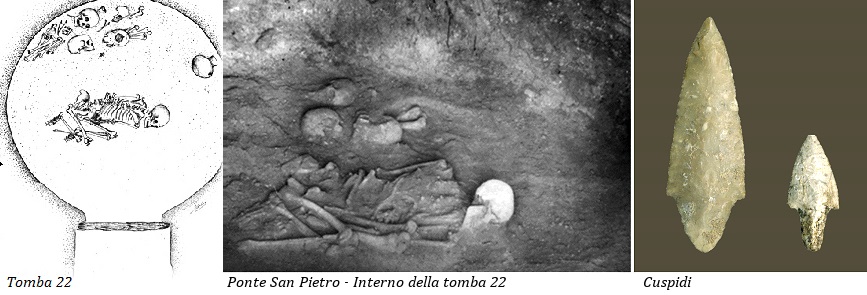
Material on display in the museum belongs to funerary sets from tombs 21 and 22, known as the "Intruso" (the Intruder) (figures above and below): the collapse of the floor of tomb 21 resulted in the body falling into tomb 22 below. Recently C14 analysis has enabled the dating of the two bodies, a male and a female, in tomb 21: the former was dated 4872±35 BP, 3750-3537 BC cal 2σ, the second 4725±33 BP 3635-3376 BC cal 2σ (Dolfini 2010).

Captions: 1. Pendant; 2. Dagger; 3. Flask; 4. Decoration on the flask
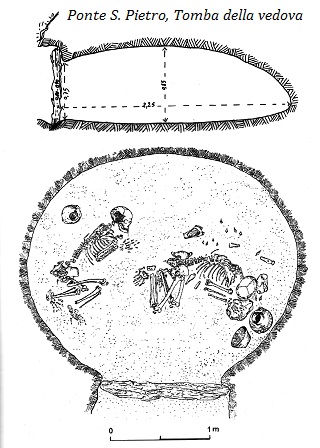
The famous "widow's tomb" was discovered inside the necropolis and is conserved at “L. Pigorini” Museum in Rome . It contains an adult male accompanied by an important funerary set, with copper and stone vases, and a woman with a fractured skull, suggesting the hypothesis of her ritual killing, following the death of her husband.
Caption (to the left): Ponte S. Pietro, Widow's tomb
Bibliography
Dolfini A. 2010, "The origins of metallurgy in central Italy: new radiometric evidence", Antiquity 84: 707–723
Miari M. 1993, "La necropoli eneolitica di Ponte S. Pietro (Ischia di Castro, Viterbo)", Rivista di Scienze Preistoriche, XLV: 101-166.
Miari M. 1994, "Il rituale funerario della necropoli eneolitica di Ponte S. Pietro (Ischia di Castro, Viterbo)", Origini, 18: 351-390.
Rittatore Vonwiller F. 1942, "Necropoli eneolitica presso il ponte San Pietro nel Viterbese", Studi Etruschi, XVI: 557-563.